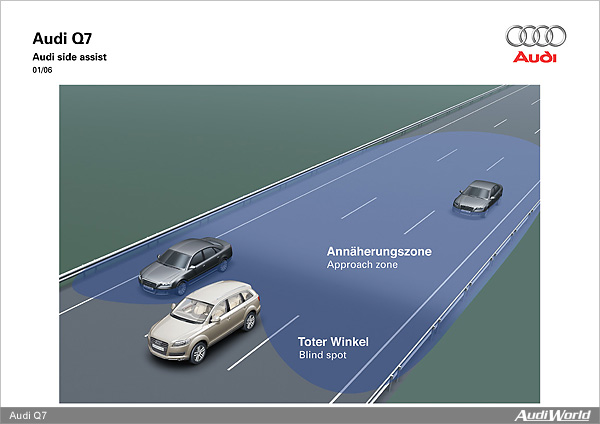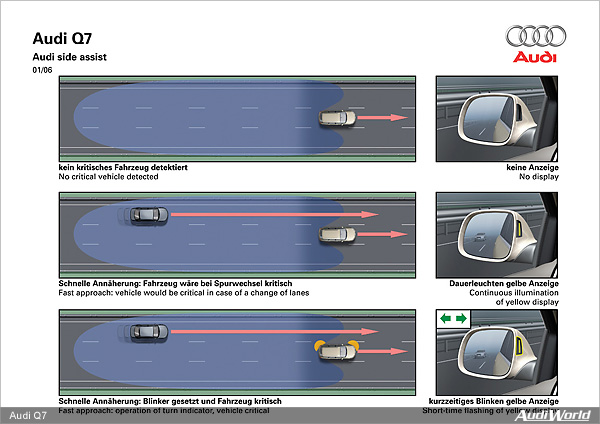The Audi Q7: Assistance Systems

Masterful and convenient The Audi Q7 is a technology demonstrator in the SUV segment not only with regard to its drivetrain and suspension. A number of optional innovative assistance systems are available to make the drivers task even easier and more convenient. adaptive cruise control A new stage in the development of the radar-assisted cruise control system including automatic distance control named adaptive cruise control is to make its debut on the Audi Q7. The new system controls distance and speed from 0 to 200 km/h. It is therefore able to brake the vehicle to a standstill behind the vehicle ahead. The Audi Q7 is the first Audi and the first SUV worldwide to feature this technology, which takes a lot of the unpleasantness out of driving on congested roads. The new system offers substantially more comfort particularly in slow-moving traffic, jams and bumper-to-bumper urban traffic, as extensive tests in major cities and on very busy main routes have shown. Often the driver does not need to stop entirely and can keep moving at a crawling speed. If he should have to stop, however, he only needs to release the brake and tap the cruise control lever on the steering column to drive off again. Four driving programs available The Audi Q7 driver enters his desired speed on the left steering column lever. Via the MMI terminal he can select one of four driving programs which determine the time interval from the vehicle in front between 1.0 and 2.3 seconds and the dynamics of the control function from sporty to comfortable. The distances are shown on the screen of the driver information system. The radar sensor for the system is discreetly mounted in the area of the licence plate trim. Compared with the first generation, it has several new features. During the journey it transmits waves at a frequency of 76.5 gigahertz they cover a distance of 180 metres (previously 150 m) and an angle of 8 degrees (previously four degrees). From the differences between the consecutive measurements the system can determine whether and how much the distance from the car in front changes; it registers the angle of the vehicle ahead in relation to the vehicles own direction of travel. The radar system is integrated in the CAN network, which covers the entire vehicle, and communicates within a few thousandths of a second with the control units for engine, transmission and brakes. The system adapts the speed of the Audi Q7 by manipulating the accelerator or brakes, whereby in both cases the main emphasis is on comfort and convenience. The braking action initiated by the system has also been deliberately limited to 4 m/s2 adaptive cruise control is designed as a convenience system. Warning in two stages In hazardous situations, for example if the driver in front suddenly brakes hard, a new technology takes intervening action braking guard. If the Audi Q7 driver does not react within a specified time, a two-stage warning is issued. Stage one consists of an acoustic signal accompanied by a prominent red flashing signal on the instrument panel. In the second stage, if there is still no response from the driver, the system triggers a short but clearly noticeable jolt, generated by a fast build-up of pressure in the brake system. At this point there is no permanent deceleration but the system shakes the driver awake with this jolt and urges him to brake hard. At the same time the brake system is automatically supplied with pressure so that full braking performance can be attained without delay when the driver applies the brake pedal. Audi engineers have identified this as the most effective solution after evaluating numerous road tests in which test persons were confronted with the most diverse warning messages. There is a very serious side to this new technology. According to a study conducted by the German Insurance Association, not paying due attention and delayed reactions even falling asleep at the wheel for a few fractions of a second are the cause of 25 per cent of all road accidents.
Audi side assist Even with all the sophisticated active driver assistance systems such as ESP, the primary objective of Audi research work is to prevent dangerous situations from arising in the first place. For this reason a designated department, the Audi Accident Research Unit analyses accidents. Their aim is to analyse those areas in which people often make mistakes and to lessen the impact of these by providing high-tech solutions in the vehicle. The new Audi side assist is one of them. Similarly to adaptive cruise control, the latest generation of Audi side assist utilises intelligent radar technology. The side assist, a world first, has been specifically designed for lane changes, as it monitors the critical blind spot. Two 24-gigahertz radar sensors in the rear bumper monitor the area next to and behind the Audi Q7 to warn the driver additionally to the image in the rear-view mirror of any approaching vehicles. The sensors have a range of up to 50 metres. LEDs in mirror housing If another vehicle is moving in the critical zone at more or less the same speed or is approaching fast from the rear, yellow LEDs in the housing of the exterior mirror light up permanently. The driver sees the LEDs only when looking in the mirror. As long as he is only looking ahead he will not notice them they are not meant to distract him. If, despite the warning, he presses the indicator lever to change lanes, the LEDs become brighter and start to flash. For licensing reasons the display on the inside of the mirror housing is directed so that practically only the driver can see it. The system adapts the brightness to the ambient lighting; in addition it can be adjusted via the MMI. It is active from a speed of 60 km/h and can also be switched off. Audi side assist does not intervene in the driving and control functions. Audi parking system advanced Audi is offering three different parking assistance systems for the Audi Q7. Already tried and tested in other model series are the parking system with acoustic signal to the rear this is standard on the Audi Q7 in many markets and the parking system plus, which additionally includes visual signals at the front and rear. The Audi parking system advanced is new and incorporates a rear-view camera. The extremely light-sensitive camera is integrated, together with its control board, in the handle of the tailgate and covers a wide area behind the vehicle with its viewing angle of 130 degrees. The images captured appear slightly distorted on the MMI screen. It withstands acceleration of up to 100 g 150 per cent more than is normally achieved when closing the tailgate. When reversing the system shows the driver the way with the help of various lines and boxes. With parallel parking, for example, blue areas show how much space is required by the Audi Q7 they clearly indicate whether the parking space is large enough. Blue lines assist when steering and countersteering. With angle parking, orange-coloured lines mark out the course. The camera image also shows the rear bumper and the extended tow hitch in this way the performance SUV can be manoeuvred with precision onto the drawbar of a boat or horse trailer. |

